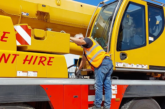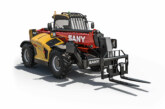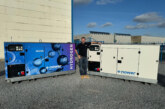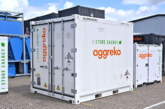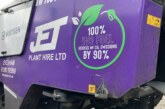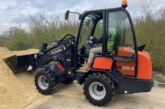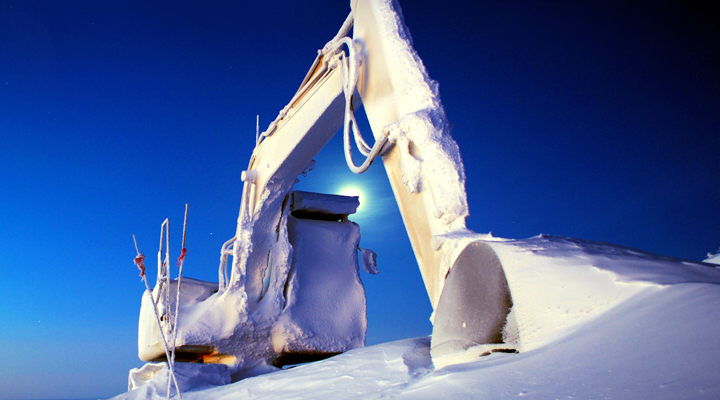
Construction Plant News Editor, Lee Jones talks to the British Antarctic Survey about the fleet of BAS vehicles and plant that makes its crucial research possible
Temperatures as low as -30°C in summer, plummeting to -50°C in the winter months, and wind speeds in gales of up to Storm Force Ten; the British Antarctic Survey undertakes its vital scientific endeavours in one of the cruellest and most unforgiving environments on earth, but that research would not be feasible at all without the considerable fleet of vehicles and plant that builds and maintain its bases. It’s the JCB Wheeled Loaders, Cat Dozers, Nodwell Cranes and much, much more that make up its 100+ armada of vehicles that keeps the two main BAS stations at Rothera and Halley operational, but just how does the machinery and its operators cope in a landscape that is as bleak as it is beautiful?
“The heavy modifications that our plant needs are carried out at our workshop in Cambridge,” explains Ben Norrish, Vehicle and Plant Manager for the British Antarctic Survey. “In the first instance there are issues with the lifting points on off-the-shelf equipment. Our base in Halley is built on a floating ice shelf, which is essentially a huge platform of ice that extends from, and is connected to, the continent, and we are loading machines onto shifting sea ice to get the units to the base. On a conventional dozer, for instance, all of the lifting points are underslung, with beams underneath the carriage. If we are unloading from ships in heavy swell that’s not a very safe way for us to proceed so instead we fabricate a shackle base.”
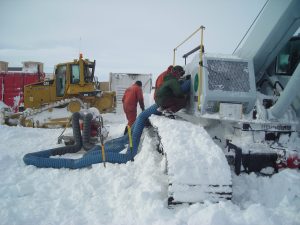 Winter’s Coming
Winter’s Coming
Clearly the biggest obstacle to be overcome in operation, however, is the extreme cold, and as a consequence the Cambridge HQ also sees a number of additional technologies retro-fitted to the plant. Webasto Pre Heat Systems, for instance, are essentially diesel fired burners, which circulate water through the engine block and back in to the burner at a heat of up to 75°C. In addition, electrical pre heat pads are fitted to any part of a machine where liquid is required to flow, such as the hydraulic tank, sump and fuel tank, whilst there’s also a 110 volt block heater as back up as well.
Other than that it is perhaps a testament to the durability of modern plant that the units are largely the same as their commercial counterparts. Remarkably, in fact, because much of the machinery is in use in the summer months – when personnel at the Halley base alone can swell to up to 60, with over 100 at Rothera – much of the equipment is actually left outside, completely exposed to the elements during the brutal assault of the winter season. When it’s time to reactivate a unit come October it can take anything up to two days to dig it out and restart the engines – but start again it will.
Cold Comfort
Plant Modifications
Experience has taught the vehicles and plant team that temperatures below -30°C will, over time, destroy rubber tracks, whilst steel tracked units have a cut off of -40°C, but engines will remain operational at temperatures as low as -50°C and below. The only reason this is largely avoided is because the longevity of the machine will ultimately be compromised, but units like the CAT D5N LGPs, of which there are two at Halley and a further unit at Rothera, are ran through the winter by the greatly reduced staff that remain to keep the stations operationally ready for the warmer months. Such operations have the added complication of the twenty four hour darkness that is the Antarctic winter.
What is completely alien to those more accustomed to a UK construction site, of course, is the conditions in which operators are required to drive those machines. “An experienced operator shouldn’t have a problem when he’s sat at the controls in the cab – he’s essentially just moving snow instead of soil – but there’s far more to consider than just that when you’re south,” continues Ben. “Halley is constantly under snow cover, even in summer, so all the machines we use at that base have to be tracked. As an example, the John Deere 7820 tractors on our fleet have their wheels replaced with tracks at our Cambridge workshop before they are deployed. “What can be more problematic is unloading onto the sea ice at Halley and working on the ice shelf itself. It can be 5 – 6 metres in thickness in places but anything thinner than 1 ½ metres becomes a challenge from a safety perspective. The only thing that will tell you the difference between good ice and bad ice is experience, and it’s something you have to assess over the course of the season.”
operators are required to drive those machines. “An experienced operator shouldn’t have a problem when he’s sat at the controls in the cab – he’s essentially just moving snow instead of soil – but there’s far more to consider than just that when you’re south,” continues Ben. “Halley is constantly under snow cover, even in summer, so all the machines we use at that base have to be tracked. As an example, the John Deere 7820 tractors on our fleet have their wheels replaced with tracks at our Cambridge workshop before they are deployed. “What can be more problematic is unloading onto the sea ice at Halley and working on the ice shelf itself. It can be 5 – 6 metres in thickness in places but anything thinner than 1 ½ metres becomes a challenge from a safety perspective. The only thing that will tell you the difference between good ice and bad ice is experience, and it’s something you have to assess over the course of the season.”
Moreover, simply starting an engine is far from a simple procedure when the mercury plunges deep into minus territory. “We simply can’t afford to push a loader or excavator to the maximum because we only have a certain store of spares. For us there are no time constraints, and just getting a vehicle up to an operational condition could take anything up to an hour every morning. Depending on the air temperature, the pre heat system has to be activated at least ½ hour before the engine starts, then you’d need to idle for a further ½ hour to move radiant heat around. Once you’ve exercised the loading shovel, or the boom and bucket, to get the hydraulics moving then you’re ready to go. At the end of the working day the shut-down procedure involves doing all that again but in reverse. In addition, we also have to conduct a whole series of pre- and post-inspection checks to make sure that the equipment is in readiness for the next user.” T
Rothera and Halley
The Rothera base is the gateway to the Antarctic, and the launch pad for deep field expeditions into the interior. Much of the plant used at the location is wheeled and in the summer months it’s essentially like working in a quarry, but, in the vital work of keeping the runway operational, snow removing equipment is still much in evidence.
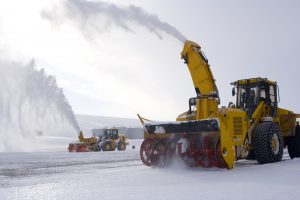 Amongst a plethora of plant, Rothera utilises a JCB 531-70 telehandler for general cargo but it’s the wheeled loaders equipped with snow blower attachments, amongst them JCB 456ZXs and 436Hs, that are the workhorses of what is the largest British Antarctic Survey station. These are true multi-purpose machines that can, with pallet fork attachments, also lift and lower cargo from the James Clark Ross and the Ernest Shackleton, the two BAS vessels that bring the comfort and technology of the 21st century to this barren world. The base’s port is subject to the raw power of nature at its most punishing, and excavators like the tracked JCB JS180 and JS130 are utilised for essential repairs to the wharf, whereas CAT 247B skid steers are used for a huge range of station support tasks.
Amongst a plethora of plant, Rothera utilises a JCB 531-70 telehandler for general cargo but it’s the wheeled loaders equipped with snow blower attachments, amongst them JCB 456ZXs and 436Hs, that are the workhorses of what is the largest British Antarctic Survey station. These are true multi-purpose machines that can, with pallet fork attachments, also lift and lower cargo from the James Clark Ross and the Ernest Shackleton, the two BAS vessels that bring the comfort and technology of the 21st century to this barren world. The base’s port is subject to the raw power of nature at its most punishing, and excavators like the tracked JCB JS180 and JS130 are utilised for essential repairs to the wharf, whereas CAT 247B skid steers are used for a huge range of station support tasks.
“Where we perhaps differ from a hirer or contractor is that we require our operators to be fully conversant with a range of different machines from a number of manufacturers. Our plant fleet is reviewed annually and individual units are regularly brought back to Cambridge for major refits. That means that an excavator of some 15 years’ vintage or more can often be as good as new when it returns to active service. It’s these units that the mechanics who are destined to go south themselves will train on, but there’s also a good deal of equipment that would not be seen in the civilian sector at all.
Core Skills
Specialised Machinery
“Our plant operators are also required to operate and maintain our Kassbohrer Pisten Bully 300 Polar units, for instance. These are used to support ice drilling, in order to extract the cores that can determine the climate on our planet millions of years ago. As highly specialised pieces of equipment we have to send our employees to the manufacturer in Germany for training. Once new recruits land on the continent of Antarctica a long induction instructs the inexperienced in coping with the environment. They need to be familiarised with all of the basic safety requirements such as where you can and cannot walk and drive. As well as that, on any large building site the workforce is far more accustomed to being alongside potentially dangerous heavy machinery. By contrast, at Rothera or Halley you’ve also got the added complications of often working with scientists who are unaccustomed to being in close proximity to an excavator.”
For further information on the work of the British Antarctic Survey visit www.antarctica.ac.uk


